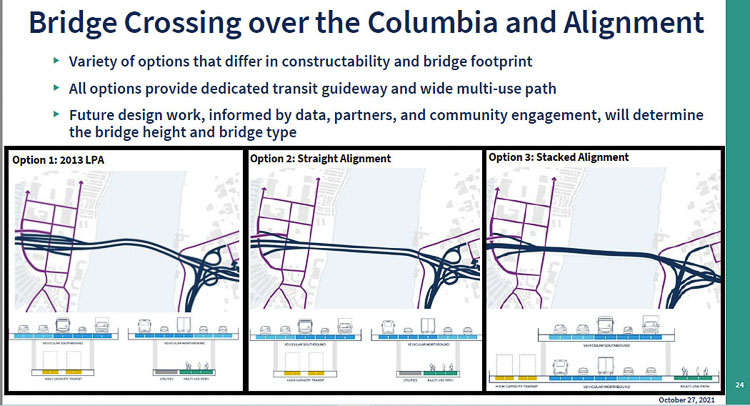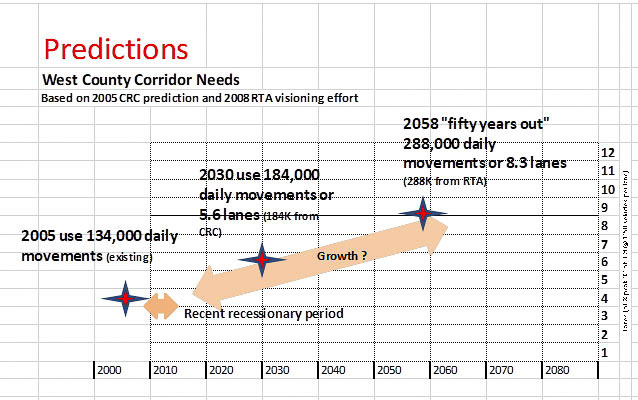Bully tone in Hardesty-Peterson letter has overtones of failed Columbia River Crossing effort
On Oct. 21, the Interstate Bridge Replacement Program’s (IBR) Executive Steering Group (ESG) held it’s monthly meeting to review progress on the project. The members were offered their first view of three design options to be considered. Before the day was over, ESG members Jo Ann Hardesty and Lynn Peterson had written a letter to program Administrator Greg Johnson expressing concerns.
The “bully tone” of the letter raised the hackles of at least two members of the Vancouver City Council. To them it appeared Portland City Councilor Hardesty and Metro President Peterson were acting more like bullies trying to force their desires on the program rather than working as co-equal partners.
“The letter was confusing and disheartening in its tone, because it felt like Metro and the city of Portland were trying to put themselves in a primary leadership role,” instead of acting like partners, said Vancouver Councilor Ty Stober.

Councilor Bart Hansen had started the conversation by asking for more details and insight into the letter. It stated Hardesty and Peterson believed the timeline was too aggressive.
Furthermore, they stated that congestion pricing needs to be matched with other regions tolling programs to determine the impacts on reducing demand. They also expressed concerns about the lane configurations according to Hansen.
Staff member Katherine Kelly responded that concerns about the timeline have been something they have been expressing for some time — “it’s nothing new.” She indicated Mayor Anne McEnerny-Ogle has also expressed concerns regarding the timeline.
“Their primary concern in the letter is the ability to have enough technical analysis completed, and enough integration of all the different elements and the analysis of those elements, coming together in time to be able to make a consideration for an IBR solution in spring,” Kelly said.
“We expect that this is a partnership and that we expect to be treated as partners in this process,” Stober said. “When words are said that don’t respect that partnership, it decreases the strength and power that has been built at this point.”
“I did get a bully sense type of tone to it.” Hansen responded. “I don’t want this bridge project to be something that’s controlled by Metro and Portland entirely. I want this to be a collaborative effort amongst all parties.”
Mayor McEnerny-Ogle responded: “we’re well aware that half that bridge is on our half of the Columbia River.”
The letter
We recognize the goal to identify an IBRP Solution by early 2022. However, we are concerned about the design options analysis. As previously expressed, to get to the IBR Solution we cannot maintain the same highway and toll rate assumptions from the Columbia River Crossing – which is currently the case in the preliminary design options. To understand the effect of holistic design, analysis must include a review of the potential for high quality transit paired
with congestion pricing at similar rates to other cities to effect transportation demand. This change in demand should inform bridge and highway design options. We urge the team to fully consider a holistic modeling and analysis approach, to ensure we can advance our shared goals as articulated in the Desired Outcomes, and to produce an evaluation supportive of the needs of decision makers. Without this analysis, we do not feel we will have enough Information to identify the best IBR solution nor answer the questions from our councils. We need to see analysis that looks at what is possible if we fully invest in transit capacity and access and integrate equitable congestion pricing. Our staff have previously shared the need for this modeling, analysis, and evaluation and remain prepared to engage and support the effort.
We want to be very clear about what we and our colleagues on the Metro Council and Portland City Council will need to make and support the necessary decisions to get us there:
- DesignOptions: We support the technical work underway to develop and explore individual design options. However, we are concerned that under the current work plan elements will only be analyzed individually as if they do not influence each other (i.e., highway design, tolling, and transit options). Further, the modeling underway is critical to make informed decisions about the IBRP Solution and some significant base assumptions have not been adequately revisited. This will not produce the information we need to make decisions on major elements such as the number of lanes crossing the river. As mentioned above, we need to see analysis that looks at what is possible if we fully invest in transit capacity and access and integrate Equitable congestion pricing.
- Desired Outcomes: we appreciate the collaboration between the IBR program and partners to gain consensus on Desired Outcomes. These statements are foundational to the work ahead and we look forward to incorporating any additional feedback provided by the Equity Advisory Group.
- Screening Criteria: we look forward to seeing how the screening criteria relate and support our ability to measure success against Desired Outcomes. We will need data from modeling, equity, and climate technical analysis to understand how options perform relative to screening criteria metrics and to identify tradeoffs.
In sum, to reach an IBRP Solution together we need to develop and agree on screening criteria, develop and agree on alternatives, analyze and measure the alternatives against the criteria, and conduct an inclusive public outreach effort — one that gives the public sufficient time to weigh in on the results of the analysis. And agency partners need sufficient time for briefings with elected officials and public boards.
During the Monday Vancouver City Council meeting, Councilors Bart Hansen and Ty Stober comment about the bully tone of a letter from two Oregon members of the IBR Executive Steering Group. They expect to be treated as partners rather than Portland simply forcing their will on Washington. Video courtesy Clark/Vancouver Television
Clark County Today emailed several questions to both Hardesty and Peterson.
In the letter you ask for “high quality transit paired with congestion pricing at similar rates to other cities to effect transportation demand.”
As background, the I-5 corridor presently has about 140,000 daily vehicle crossings. Using the CRC data, it was projected to have about 180,000 daily movements by 2030, and 290,000 daily movements by 2060.
#1 — How many cars and trucks would you like to see removed from I-5, as part of your request to “effect transportation demand”?
#2 — Please provide details on what “high quality transit” would look like, how much you think it would cost, and how many vehicles it would take off the road?
#3 — Finally, how much should the tolls be in your desired congestion pricing, and how many vehicles would that take off the road?
#4 — Would it be acceptable if the toll rates (congestion pricing) shifted the travel times to other parts of the day, or should the goal of congestion pricing be to either stop people from driving or use mass transit?
The only response provided was from the Metro media contact saying “we have no comment at this time.”

Citizens have overwhelmingly asked that traffic congestion relief be the top priority in addressing the I-5 corridor and a replacement bridge. They are also very sensitive about Portland trying to force their MAX light rail on Clark County in the failed CRC. The Clark County Council recently reaffirmed traffic congestion relief as their top priority for the project.
One person familiar with the letter said Portland was already acting like a bully with their tolling plans. With over 75,000 Clark County and Southwest Washington citizens crossing the river every day for work (pre-pandemic) the greatest impact of tolling will fall on Washington residents.
In the failed Columbia River Crossing, it was estimated that 60 percent of the tolls would be paid by Washington residents.




